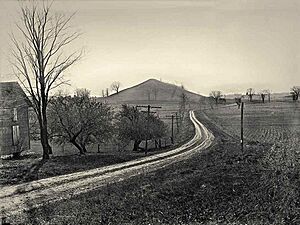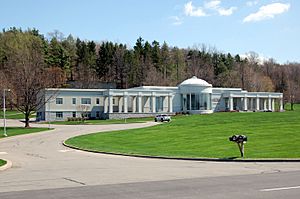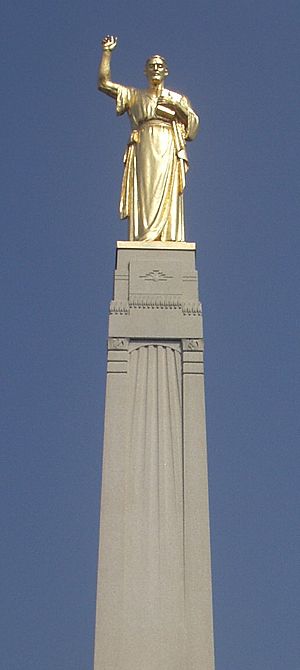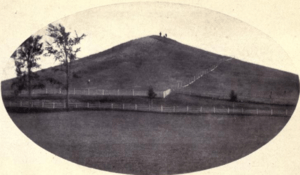Cumorah facts for kids
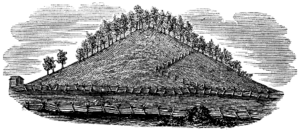
Cumorah is a special hill in Manchester, New York, United States. It is also known as Mormon Hill or Gold Bible Hill. This hill is important to members of The Church of Jesus Christ of Latter-day Saints.
According to Joseph Smith, the founder of the Latter-day Saint movement, he found ancient golden plates on this hill. He said he translated these plates into English, and they became the Book of Mormon.
In the Book of Mormon itself, "Cumorah" is also the name of a hill in a land with "many waters, rivers and fountains." A prophet named Mormon hid many metal plates inside this hill. These plates contained the history of his people, the Nephites. This happened just before a huge battle where many Nephites were killed by another group called the Lamanites.
Early members of the Latter Day Saint movement believed the Cumorah in New York was the same hill described in the Book of Mormon. This idea came from a letter written by Oliver Cowdery in 1835. However, some scholars later wondered if there might be two different hills named Cumorah. One would be in New York, and the other in a place like Mexico or Central America. The Church of Jesus Christ of Latter-day Saints does not have an official rule on this.
Joseph Smith officially stated that the angel Moroni appeared to him in Manchester, New York.
Contents
The Hill in New York
The hill in Manchester, New York, is where Joseph Smith said he found the golden plates. He wrote that the plates were "on the west side of this hill, not far from the top, under a stone of considerable size." They were placed inside a stone box.
Joseph Smith visited the hill every year on September 22 from 1823 to 1827. He said an angel, whom he called Angel Moroni, taught him during these visits. On September 22, 1827, Joseph Smith was finally allowed to take the plates. Later, eleven other men also said they saw and held the plates.
Before 1829, the hill didn't have a specific name. It was a few miles from Joseph Smith's childhood home. The hill was formed by glaciers during the Ice Age. It rises about 110 feet (34 meters) above the land around it.
Since 1829, Latter-day Saints have called it "Cumorah." Local people who are not Latter-day Saints often call it "Mormon Hill" or "Gold Bible Hill." The Church of Jesus Christ of Latter-day Saints bought the hill and the land around it in the 1920s.
Today, there is a monument on top of the hill with a statue of the Angel Moroni. At the bottom of the hill, there is a visitor center where people can learn more.
Where the Plates Were Found
Joseph Smith described finding the plates in a stone box on the west side of the hill, near the top. However, this stone box has not been found. Soon after Joseph Smith announced he had the plates, some local people looked for a freshly dug hole on the hill but didn't find one. They did notice an old, large hole on the east side of the hill, dug years before by people looking for treasure.
Cumorah in the Book of Mormon
The Nephites' Story
The Book of Mormon mentions Cumorah six times. It talks about a prophet named Mormon who was in charge of keeping the records of his people. He put together and shortened many records and wrote them on gold plates.
Mormon's people, the Nephites, were facing destruction from the Lamanites. Mormon asked the Lamanite leader if his people could gather at "the land of Cumorah, by a hill which was called Cumorah." He said this land had "many waters, rivers, and fountains."
The Lamanite leader agreed. All the Nephites, including women and children, gathered there. Mormon wrote that after 384 years (since the birth of Christ), they had all gathered to the land of Cumorah. Mormon then hid most of his people's records inside the hill. He only kept the plates he was writing on, which he gave to his son, Moroni.
The Lamanites then attacked the Nephites. Mormon wrote that almost all of his people were killed in this huge battle. Only 24 Nephites survived with him, along with some who fled or joined the Lamanites.
Mormon then shared his sadness for his people and wrote a final message. He gave the remaining records to his son, Moroni. Moroni later wrote that after the "great and tremendous battle at Cumorah," the remaining Nephites were hunted down and destroyed. Moroni's father, Mormon, was also killed. Moroni wrote that he was left alone to finish the sad story.
The Jaredites' Story
The Book of Mormon also tells about an even older group of people called the Jaredites. They called this same hill "Ramah."
The land of Cumorah was part of a larger area called Desolation. This land was where an earlier civilization had been destroyed. The Book of Mormon says this land was north of another place called Zarahemla.
Moroni lived for several years after his people were destroyed. He translated and shortened the records of the Jaredites, which became the Book of Ether. He wrote that a Jaredite leader named Omer "passed by the hill of Shim, and came over by the place where the Nephites were destroyed." He also wrote that the army of Coriantumr camped by "the hill Ramah; and it was that same hill where my father Mormon did hide up the records unto the Lord." This means that the Nephite hill Cumorah was the same hill where the Jaredites fought their final battle.
Discussions About the Hill's Location
For over 100 years, most Latter-day Saints believed the Hill Cumorah in New York was the only one. But since the early 1900s, some scholars have wondered if there are two hills named Cumorah. One would be in New York, and the other in a place like Southern Mexico, Central America, or South America. Most Latter-day Saint archaeologists believe in the "two Cumorahs" idea. However, some leaders and members still believe there is only one Cumorah.
The New York Hill
Several accounts describe events that happened at the Hill Cumorah in New York. For example, Brigham Young said that the angel told Joseph Smith to bring the golden plates back to the hill. When Joseph Smith and Oliver Cowdery arrived, "the hill opened, and they walked into a cave." Inside the cave, they saw many plates piled up. They also saw the Sword of Laban hanging on the wall.
No archaeological digs have been done at the Hill Cumorah in New York.
The Hill Cumorah Pageant
The land around the Hill Cumorah in New York is home to the annual Hill Cumorah Pageant. This is a large outdoor play that tells stories from the Book of Mormon. It usually happens in early July and is free to attend. The pageant started in 1935. The show's current name, America's Witness for Christ, began in 1937. The pageant was planned to have its last performance in 2020, but due to the coronavirus pandemic, it was rescheduled for July 2021.
- Sites from former cast members: Hill Cumorah.net
See also
 In Spanish: Cumorah para niños
In Spanish: Cumorah para niños


